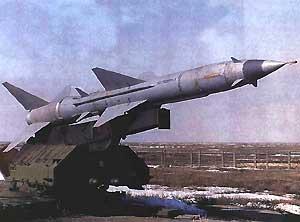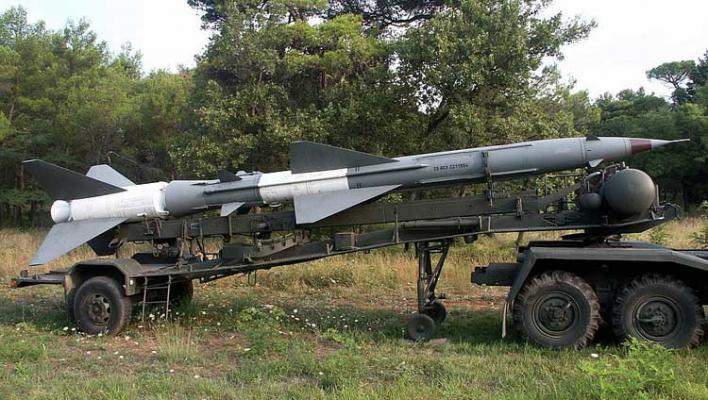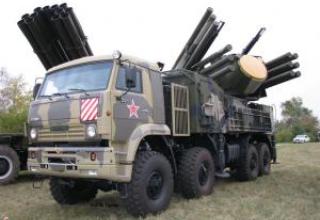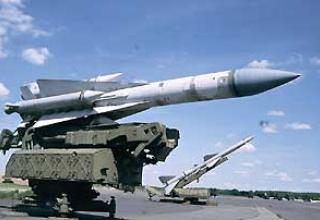At the MAKS-2001 exhibition, Almaz Research and Production Association presented a variant of the upgraded S-75 ("Volga") anti-aircraft missile system, which is currently in service with air defense forces of dozens of countries.
Upgrading of the Volga SAM system to the level of Volga-2 provides for upgrading the characteristics of the system to ensure successful fight against modern means of air attack in a complex interfering environment through the use of technology and component base of S-300PMU1-2 SAM systems.
The S-75-2 anti-aircraft missile system ensures the defeat of bombers, strategic bombers, fighter-bombers, multi-purpose aircraft, ultra high-speed reconnaissance aircraft, automatic drifting aerostats and cruise missiles with an effective scattering surface of 0.2m2 or more.
Composition:
The system includes an anti-aircraft missile system (SAM), 5Y23 or 20D antiaircraft guided missiles (ALCM) and technical support facilities.
SAMs include the following fixed assets:
- The RSN-75B radar tracking and pointing station, located on three trailers (receiving and controlling, apparatus cabin). The RSN_75V has radar and TV support channels operating in automatic and manual modes.
- There are six launchers with one missile on each.
- Means of power supply.
The complex is single-channel by target. In addition, radar detection and target designation stations P-12 and P-15 can be attached. SAM equipment is placed in transported trailers and semi-trailers, communication between them is carried out via cable. Electric power supply to the complex is provided by mobile diesel-electric stations. It is possible to connect to industrial networks.
ZUR 20D and 5YA23 are two-stage, made according to normal aerodynamic scheme with destabilizers in the front part. The first stage is a solid propellant rocket engine with stabilizers installed on it, the second stage is equipped with a liquid propellant rocket engine with a pumping system of fuel components supply. Structurally, the marching stage consists of a number of compartments, which contain a radio detonator, shrapnel and high-explosive combat unit, units of on-board equipment, tanks with fuel components, liquid rocket engine, units of rudder fall, receivers of control commands.
Launch of the rocket - inclined, with the launcher, guided by the angle of the place and azimuth. Missile flight control and pointing at the target is carried out by radio commands coming from the ground guidance station, and the detonation of a combat unit - by a command of a radio detonator or by a command coming from the ground station when approaching the target at the necessary distance.
Modernization of SAMs is carried out using technology and the element base of SAMs S-300PMU1-2 and includes:
- to increase target channel security.
- Introducing audible target indication in radar mode.
- Introducing auto target tracking in TCE mode.
- replacing the following analogue computing devices with digital equipment:
- Target and missile positioning devices (TOC);
- development of missile control commands (ICS);
- an automated launch device (ASAT);
- subtraction devices of SDC;
- Interference demodulation devices (ICD);
- station synchronizer;
- training and control equipment.
This will increase missile guidance accuracy and target range by applying a modern missile guidance method and the optimal way to process target and missile signals. In addition, the number of equipment in HV and AB cabins is reduced by about half.
From the HE and AB are removed 66 blocks of 135.
As a result of modernization, the RSN-75 will be able to:
- in RK mode:
- detect, escort and guide missiles to targets that are under the cover of an AASP on the background of the DNA at a density of 2000 W/MHz with the equivalent range of Ke=100km in the entire area of the missile's air defense engagement in the active section of the missile's flight;
- to open the range to the ASD operator within the zone of engagement in the active section of the missile due to the operation of coherent storage devices and algorithms for tying the routes in the SW;
- detect, escort and guide the missiles to small-size targets and STELS-type targets in the entire zone of engagement of the air defense systems in the active region of the missile's flight by increasing the sensitivity of the station in the mode of coherent accumulation of ~16 dB;
- to increase the target detection and tracking range;
- eliminate the influence of "locals" and meteors on the second sweep of the range in the mode of SDC;
- increase the target range to 60 km;
- increase the firing efficiency by increasing the accuracy of calculations, elimination of "zero" drifts, application of optimal methods of signal processing and guidance of missiles to the target;
- to provide target tracking on extended coordinates, in case of temporal loss of target visibility in radar or TVK;
- to carry out automatic control of the newly introduced digital equipment and diagnostics of the fault with the accuracy to the replacement element.
- in TCE mode:
- to perform (sequentially) automatic capture of targets (up to 2);
- automatically accompany the selected target, determining its angular coordinates relative to the center of the screen with an accuracy of 0.02 mrad;
- determine in the MB mode the height of the target above the horizon, which allows to increase the accuracy of pointing the missiles at low-flying targets, and, therefore, increase the probability of their hitting.
After modernization the performance of RSH-75 is improved.
- the number of service personnel is being reduced;
- power consumption is reduced by 40%;
- better ergonomic working conditions for the guidance officer, by displaying information on the coordinates and parameters of target movement, forming a "guaranteed kill zone";
- partially automates the work of the guidance officer;
- reliability of the RSN is increased;
- decreases the time and number of routine work;
- availability of replaceable RS calculation training programs as part of special calculator software significantly expands opportunities for training and education of RS operators, guidance officer and shooter.
Upgrading works of HV and AB cabins can be carried out, at the customer's request, at the location or at the production base.
Characteristics:
| Feature | "Volga" | "Volga-2" |
| Defeat zones | ||
| Altitude range, km | 0.1-30 | 0.1-30 |
| Maximum range at an altitude of 0.5 km | 24km | 27km |
| Maximum range at an altitude of 5-25 km | 40-55km | 45-60km |
| Maximum range at an altitude of 30 km | 50km | 55km |
| Maximum parameter at 0.5 km height | 22km | 26km |
| Maximum parameter at an altitude of 5-25 km | 38-50km | 40-50km |
| Maximum parameter at an altitude of 30 km | 34km | 45km |
| Probability of hitting the target with one missile | ||
| * at a distance of up to 50 km | 0.4-0.97 | 0.56-0.98 |
| * at a range of 50-60 km | - | 0.41-0.98 |
| Noise immunity characteristics | ||
| Interference that takes you around the corner: | ||
| * escort angles (with SHV) | 2.5'-4' | 1.5'-2' |
| * escort angular errors (no GSW) | 6.0'-12' | 1.0'-2' |
| Breeding of moving targets | ||
| *Corneral target tracking errors in the background of reflections from local objects and passive interference | 3'-5' | 3'-4' |
| *" Angular target tracking errors in "MV" " | up to 15' | 3'-4' |
| * rollover of target tracking against the background of reflections from local objects | no | yes |
| * worked in ASP on DNA background (Rn=100km), W/MHz | 100 | 2000 |
| Pulse response interference (pseudo-random repetition period vobulation) | no | yes |
| Target auto capture time on AC,s | 8 | 2.5-3 |
| Number of controlled parameters during routine maintenance work | ||
| on a weekly basis | 257 | 99 |
| on a 5-week rule | 498 | 228 |
| seasonally | 580 | 267 |
| Time of regulatory work | - | is reduced by 2-2.5 times |
| Starting device | ||
| operational mode | semi-automatic machine | automatic rifle |
| data production time,s | 7 | 2 |
| point of encounter accuracy,km | 2.0-5.0 | 0.5 |
| blank range indication | no | yes |
| target form display (azimuth, position angle, range, altitude, speed, parameter, current miss) | no | yes |
| Operation of TVK A3 and AC purposes (2 channels) | no | yes |
| Current Functional Control | no | yes |
| RS-based system of internal stationary measurements and combat documentation | no | yes |
Missiles:
| Rocket | 20D (V-755) | 5Ya23 |
| Starter weight, kg | 2390-2398 | 2406 |
| Weight BC, kg | 196 | 190-197 |
| Length, m | 10.78 | 10.9 |
| Diameter of the body of the march step, m | 0,5 | 0,5 |
| Accelerator stabilizer swing, m | 2.57 | 2.57 |
Testing:
The first combat use of the S-200 SAM system took place in 1982 in Syria, where at a distance of 190 km the E-2C "Hawkeye" DRLO was shot down, after which the American aircraft carrier fleet withdrew from the Lebanese coast. The Libyan S-200 complexes took part in repulsing an attack by American FB-111 bombers and possibly shot down one bomber.
On the basis of the 5B28 anti-aircraft missile of the S-200B complex a hypersonic flying laboratory "Cold" has been created to test hypersonic direct-flow air jet engines. The choice of this missile was based on the fact that the parameters of its flight path were close to those required for flight tests of the Hyper-Sonic Propulsion System. It was also considered important that the missile had been decommissioned and its cost was low. The missile's combat unit was replaced by the head compartments of the GLL "Kholod", which housed the flight control system, a liquid hydrogen tank with displacement system, a hydrogen flow control system with measuring devices and, finally, the experimental HPVRD E-57 of axially symmetric configuration.
Sources:
- "S-75M3Air defense missile system'". Рекламный проспект НПО "Алмаз"
- С-300 дает новую жизнь "Печоре"
- Зенитный ракетный комплекс средней дальности С-75 (SA-2 Guideline)







